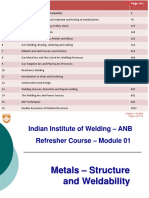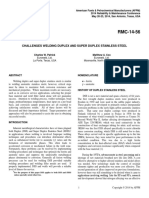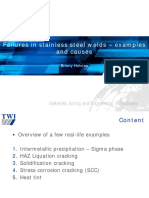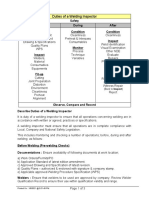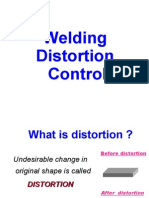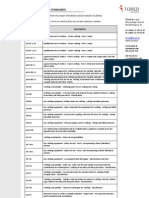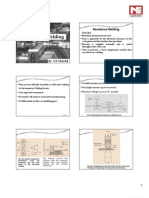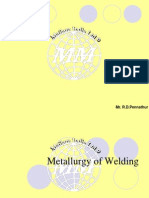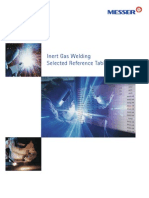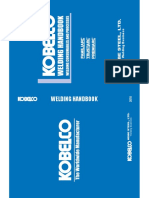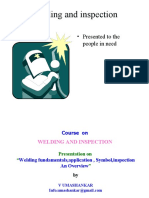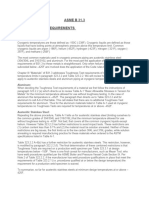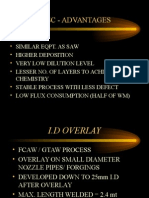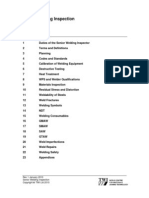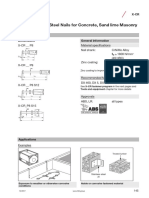0 ratings0% found this document useful (0 votes)
200 views6 Shielding Gases For Welding Stainless Steels - Glenn Allen - TWI PDF
6 Shielding Gases For Welding Stainless Steels - Glenn Allen - TWI PDF
Uploaded by
hailay83Copyright:
© All Rights Reserved
Available Formats
Download as PDF, TXT or read online from Scribd
6 Shielding Gases For Welding Stainless Steels - Glenn Allen - TWI PDF
6 Shielding Gases For Welding Stainless Steels - Glenn Allen - TWI PDF
Uploaded by
hailay830 ratings0% found this document useful (0 votes)
200 views23 pagesOriginal Title
6 Shielding gases for welding stainless steels - Glenn Allen - TWI.pdf
Copyright
© © All Rights Reserved
Available Formats
PDF, TXT or read online from Scribd
Share this document
Did you find this document useful?
Is this content inappropriate?
Copyright:
© All Rights Reserved
Available Formats
Download as PDF, TXT or read online from Scribd
Download as pdf or txt
0 ratings0% found this document useful (0 votes)
200 views23 pages6 Shielding Gases For Welding Stainless Steels - Glenn Allen - TWI PDF
6 Shielding Gases For Welding Stainless Steels - Glenn Allen - TWI PDF
Uploaded by
hailay83Copyright:
© All Rights Reserved
Available Formats
Download as PDF, TXT or read online from Scribd
Download as pdf or txt
You are on page 1of 23
Shielding Gases for
Welding Stainless Steels
Glenn Allen IWE
Copyright © TWI Ltd 2015
Shielding Gases for Stainless Steels
The material contained in this powerpoint
presentation has kindly been supplied by:
Bob Eden, EngTech TechWeldI,
Technical Support Engineer, BOC
robert.eden@boc.com 07717 480910
Copyright © TWI Ltd 2015
Shielding Gases for Stainless Steels
Copyright © TWI Ltd 2015
Shielding Gases for Stainless Steels
Shielding Gas affects
Shielding effect
Welding Speed
Corrosion and mechanical properties
Arc stability
Weld profile
Surface appearance
Copyright © TWI Ltd 2015
Shielding Gases for Stainless Steels
No single gas has an optimum suitability for all
shielding applications.
Different gases exhibit different characteristics
that can be used to influence the welding ard and
deposited weld metal.
Each component of a shielding gas mixture is
carefully selected to provide optimum benefits, in
quantities from 0.05% - 100%.
Copyright © TWI Ltd 2015
Shielding Gases for Stainless Steels
Gas Components
Copyright © TWI Ltd 2015
Shielding Gases for Stainless Steels
Thermal Conductivity of shielding gas components
Copyright © TWI Ltd 2015
Shielding Gases for Stainless Steels
Effects of gases on welds
Helium
Broader/deeper penetration profile
Increased deposition rates
Flatter weld beads
May decrease arc stability
Hydrogen
Deeper penetration
Increased deposition rates
Mainly used for austenitics (to avoid hydrogen
cracking)
Advantages of CO2 compared to O2
Better penetration
Increased deposition rates
Copyright © TWI Ltd 2015
Shielding Gases for Stainless Steels
MIG / MAG Welding
Oxidising components are added to Argon
to stabilise the arc (2-4% CO2, 1-2%O2)
Excessive oxidation will occur on
‘stainless steels’ with more than these
levels.
Excessive He can cause arc instability.
Copyright © TWI Ltd 2015
Shielding Gases for Stainless Steels
Effects on arc stability
Argon Argon + 2.5% CO2
Copyright © TWI Ltd 2015
Shielding Gases for Stainless Steels
Effects of Oxygen, Carbon Dioxide & Helium
Ar + 2%O2 Ar + 2.5%CO2 Ar + 2%CO2 +38%He
Copyright © TWI Ltd 2015
Shielding Gases for Stainless Steels
TIG welding; Effects of He & H2
100% Ar Ar + 50%He 100% He
100% Ar Ar + 5%H2 Ar + 15%H2
Copyright © TWI Ltd 2015
Shielding Gases for Stainless Steels
TIG welding; Effects of H2 on profile
Same parameters
Argon Argon + H2
Copyright © TWI Ltd 2015
Shielding Gases for Stainless Steels
TIG welding; Effects of H2 on profile
Increased speed
Argon Argon + H2
Copyright © TWI Ltd 2015
Shielding Gases for Stainless Steels
TIG welding; Effects of Helium on profile
Same parameters
Argon Argon + 30%He Argon + 50%He
Copyright © TWI Ltd 2015
Shielding Gases for Stainless Steels
TIG welding; Effects of Helium on profile
Increased speed
Argon Argon + He
Copyright © TWI Ltd 2015
Shielding Gases for Stainless Steels
Corrosion Resistant properties
Oxidizing components may decrease corrosion
resistance
Loss of alloying elements
Increase in surface oxides
Hydrogen reduces surface oxide formation
Nitrogen increases corrosion resistance
(pitting)
Nitrogen alloyed stainlesses, ie Duplexes
Copyright © TWI Ltd 2015
Shielding Gases for Stainless Steels
Influence of gases on oxide formation, TIG
Argon Ar + 1.5% H2 Ar + 5% H2
Copyright © TWI Ltd 2015
Shielding Gases for Stainless Steels
Influence of gases on oxide formation, MAG
Ar + 2% O2 Ar + 2.5% CO2 Ar + 2% CO2 + 38% He
Copyright © TWI Ltd 2015
Shielding Gases for Stainless Steels
Influence of shielding gas on Distortion.
Copyright © TWI Ltd 2015
Shielding Gases for Stainless Steels
Consult your gas supplier!
Copyright © TWI Ltd 2015
Copyright
Presentation prepared by TWI for the
Stainless Steel – Quality Fabrication Seminar
TWI holds copyright on this presentation.
All rights reserved. No part of this presentation may be
reproduced or transmitted in any form or by any means,
electronic or mechanical, including photocopy, recording,
or any information storage and retrieval system, without
the express permission of TWI.
Copyright © TWI Ltd 2015
End of presentation
Any Questions
glenn.allen@twi.co.uk
bob.eden@boc.com
Copyright © TWI Ltd 2015
You might also like
- Iws Materials and Their Behaviour PDFDocument282 pagesIws Materials and Their Behaviour PDFscott2355100% (10)
- IIW Diploma - DAC1 Course Notes PDFDocument243 pagesIIW Diploma - DAC1 Course Notes PDFTan Billy75% (4)
- Module 1 16 - IIWDocument1,119 pagesModule 1 16 - IIWsree100% (2)
- Aws b2.1.1.205Document25 pagesAws b2.1.1.205Aliakbar Ghaderi100% (2)
- Construction and DesignDocument2 pagesConstruction and DesignAnthony Abel100% (1)
- TWI ppt-WPE1-Course-Notes PDFDocument72 pagesTWI ppt-WPE1-Course-Notes PDFA. ΒρατσισταNo ratings yet
- IIW - Welding DefectsDocument31 pagesIIW - Welding Defectsvarundevil87No ratings yet
- TWI Welding Training 4Document36 pagesTWI Welding Training 4Simbu Arasan100% (1)
- Challenges Welding Duplex and Super Duplex Stainless Steel (Matt Article) PDFDocument13 pagesChallenges Welding Duplex and Super Duplex Stainless Steel (Matt Article) PDFewillia13No ratings yet
- 04 Briony Holmes - TWI PDFDocument32 pages04 Briony Holmes - TWI PDFSupratim Biswas100% (2)
- Welding IiwDocument6 pagesWelding IiwletsmakeithappenNo ratings yet
- DAC3 March 2012Document319 pagesDAC3 March 2012John Boran100% (1)
- IIW World OverrviewDocument4 pagesIIW World OverrviewAnonymous hBBam1nNo ratings yet
- Gas Cutting WLDNG Process - 06-Rev.4Document81 pagesGas Cutting WLDNG Process - 06-Rev.4Asad Bin Ala QatariNo ratings yet
- TWI CSWIP 3.1 Wis 5 Welding Inspection Heat Treatment: World Centre For Materials Joining TechnologyDocument9 pagesTWI CSWIP 3.1 Wis 5 Welding Inspection Heat Treatment: World Centre For Materials Joining TechnologyOnur AltuntaşNo ratings yet
- The Indian Institute of WeldingDocument11 pagesThe Indian Institute of WeldingNnamdi Celestine NnamdiNo ratings yet
- Course Fully Sponsored By: (W International Institute of Welding (IIW) Diploma of International Welding Specialist (IWS)Document8 pagesCourse Fully Sponsored By: (W International Institute of Welding (IIW) Diploma of International Welding Specialist (IWS)SanthaKumar Muthu ThankaveluNo ratings yet
- WPE2 Course Notes PDFDocument356 pagesWPE2 Course Notes PDFQuoc Vinh100% (3)
- IWSD M3 - 4 - Analysis Methods For StructuresDocument58 pagesIWSD M3 - 4 - Analysis Methods For StructuresPourya NouryNo ratings yet
- Iws Materials and Their Behaviour PDFDocument282 pagesIws Materials and Their Behaviour PDFkatfy1No ratings yet
- IIW Diploma - WPE1 Course Notes PDFDocument300 pagesIIW Diploma - WPE1 Course Notes PDFTan Billy100% (2)
- Ttransition JointsDocument15 pagesTtransition JointsAdil HasanovNo ratings yet
- Material BehaviorDocument111 pagesMaterial BehaviorFajar LuqmanNo ratings yet
- PRES TIG Hot Wire Narrow Gap Welding enDocument25 pagesPRES TIG Hot Wire Narrow Gap Welding enRavishankarNo ratings yet
- WI 01 - Introduction To WI ModuleDocument14 pagesWI 01 - Introduction To WI ModuledayalramNo ratings yet
- Iws Fabrication Application PDFDocument245 pagesIws Fabrication Application PDFScott Trainor100% (1)
- WIS10 M.TestDocument46 pagesWIS10 M.TestUmaibalan100% (1)
- Book - Vol.1&2 - BasicsAndQuality - 22junDocument82 pagesBook - Vol.1&2 - BasicsAndQuality - 22junlth770310No ratings yet
- Duties of Welding ManagerDocument3 pagesDuties of Welding ManagerBalkishan DyavanapellyNo ratings yet
- Wtia Iiw Iwe V3 - 0 PDFDocument2 pagesWtia Iiw Iwe V3 - 0 PDFRizwan Nazir100% (1)
- Minimum Requirements IweDocument52 pagesMinimum Requirements IweIonutz TelteuNo ratings yet
- International Welding Engineer IWE CVDocument4 pagesInternational Welding Engineer IWE CVlaz_k50% (2)
- Sample Questions and Answers For IWP Examinations PDFDocument15 pagesSample Questions and Answers For IWP Examinations PDFElizabeth Spence100% (3)
- Introduction To Welding - MetallurgyDocument15 pagesIntroduction To Welding - Metallurgyramkishore_87100% (1)
- 8-Welding Distortion & ControlDocument61 pages8-Welding Distortion & ControlRaj Chodankar100% (1)
- 09-MMA Welding 2006Document19 pages09-MMA Welding 2006Rob WillestoneNo ratings yet
- 1.0 Typical Duties of Welding InspectorsDocument27 pages1.0 Typical Duties of Welding InspectorsTruong Gia Phu100% (1)
- Inconel 625 Welding MetallurgyDocument8 pagesInconel 625 Welding MetallurgyMoses_Jakkala100% (1)
- Wtia Iiw Iwe V3 - 0Document2 pagesWtia Iiw Iwe V3 - 0Rizwan NazirNo ratings yet
- Material InspectionDocument25 pagesMaterial InspectionAhmed Gomaa100% (2)
- Welding NormsDocument14 pagesWelding NormsimupathanNo ratings yet
- Wis5 WPS 05Document22 pagesWis5 WPS 05Gibson FisherNo ratings yet
- 1.2 Resistance and Special WeldingDocument14 pages1.2 Resistance and Special WeldingnikhilbathamNo ratings yet
- Preheat PDFDocument11 pagesPreheat PDFromanosky11No ratings yet
- Welder and Wps Qualification Control ProcedureDocument24 pagesWelder and Wps Qualification Control ProcedurejhuliocessarsNo ratings yet
- TWI CSWIP 3.1 Wis 5 Welding Inspection Four Factors: World Centre For Materials Joining TechnologyDocument7 pagesTWI CSWIP 3.1 Wis 5 Welding Inspection Four Factors: World Centre For Materials Joining TechnologyOnur AltuntaşNo ratings yet
- Duties of The RWCDocument3 pagesDuties of The RWCbluegalago100% (1)
- Asme Ix Welder Qualification Interpretation PDFDocument95 pagesAsme Ix Welder Qualification Interpretation PDFnizam1372No ratings yet
- Competitive Solutions For Joining TechnologyDocument19 pagesCompetitive Solutions For Joining Technologyjy12bhu100% (1)
- Welding Metallurgy IIW Presentation ANB Program Dec 2011Document88 pagesWelding Metallurgy IIW Presentation ANB Program Dec 2011Asad Bin Ala Qatari100% (5)
- Certificate No. / 74 / W/ 01: Welder S Certificate ISO 9606-1 111 P BW FM1 RB T 20 PA SS, NBDocument1 pageCertificate No. / 74 / W/ 01: Welder S Certificate ISO 9606-1 111 P BW FM1 RB T 20 PA SS, NBDeepak Das100% (1)
- Welding Engineering PDFDocument5 pagesWelding Engineering PDFRupesh KodreNo ratings yet
- Welding Metallurgy and Weldability of Nickel-Base AlloysFrom EverandWelding Metallurgy and Weldability of Nickel-Base AlloysRating: 5 out of 5 stars5/5 (1)
- About Titanium WeldingDocument6 pagesAbout Titanium Weldingckkashyap0007No ratings yet
- WIS5 Imperfections 2006 PDFDocument81 pagesWIS5 Imperfections 2006 PDFWatcharapong Puangthaisong100% (1)
- Inert Gas Welding Indert Gas Welding Selected Reference TablesDocument6 pagesInert Gas Welding Indert Gas Welding Selected Reference Tableshooky1No ratings yet
- Consumables General PowerpointDocument10 pagesConsumables General PowerpointMorg ActusNo ratings yet
- Az Vs Gi BrochureDocument2 pagesAz Vs Gi Brochurepartho4No ratings yet
- Weldability of Steels: CSWIP 3.1 Welding InspectionDocument105 pagesWeldability of Steels: CSWIP 3.1 Welding InspectionLương Hồ Vũ100% (1)
- Scribe LineDocument1 pageScribe Linehailay83No ratings yet
- 4 Year 4th-Year - Module 1 "Selection and Recruitment": Test FormatDocument32 pages4 Year 4th-Year - Module 1 "Selection and Recruitment": Test Formathailay83No ratings yet
- Kobel CoDocument2 pagesKobel Cohailay83No ratings yet
- Cswip 3.1. Heat TreatmentDocument81 pagesCswip 3.1. Heat Treatmenthailay8375% (4)
- The Tie That Binds: Science PeopleDocument178 pagesThe Tie That Binds: Science Peoplehailay83No ratings yet
- Operating Manual For KTS-6080S (Unitech)Document12 pagesOperating Manual For KTS-6080S (Unitech)hailay83No ratings yet
- Pipings and FittingsDocument3 pagesPipings and Fittingshailay83No ratings yet
- Steel Manual Book2Document217 pagesSteel Manual Book2hailay83No ratings yet
- ArtifactDocument13 pagesArtifactMuhammad ZariqNo ratings yet
- Useful Piping & Structural DataDocument172 pagesUseful Piping & Structural Datahailay83No ratings yet
- Iso 9016Document12 pagesIso 9016hailay83No ratings yet
- Tpo Runeil rt1Document28 pagesTpo Runeil rt1hailay83No ratings yet
- 1 API IndexDocument20 pages1 API Indexhailay83No ratings yet
- Shell Perdido Article PDFDocument72 pagesShell Perdido Article PDFhailay83100% (2)
- AMCRPS Piling Handbook9thDocument471 pagesAMCRPS Piling Handbook9thSamuel CancinosNo ratings yet
- Welding Qualification: by L D PoyyaraDocument45 pagesWelding Qualification: by L D PoyyaraAshish GhadiyaNo ratings yet
- Seminar 1 - Stainless Steel and Its ApplicationsDocument105 pagesSeminar 1 - Stainless Steel and Its ApplicationspripramadaNo ratings yet
- Property Name: Die Casting Centrifugal Casting Investment CastingDocument11 pagesProperty Name: Die Casting Centrifugal Casting Investment CastingjohnblackburnNo ratings yet
- Module 06 - Materials & HardwareDocument1,090 pagesModule 06 - Materials & HardwaresreeramNo ratings yet
- Welding Training InspectionDocument46 pagesWelding Training InspectionAdhanom G.No ratings yet
- Automotive Engine ValveDocument61 pagesAutomotive Engine Valvemvv-sspNo ratings yet
- Anatomy of A Grooved JointDocument6 pagesAnatomy of A Grooved JointHowardNo ratings yet
- A10 Effects of Welding Processes On The Mechanical Properties of HY 80 Steel WeldmentsDocument9 pagesA10 Effects of Welding Processes On The Mechanical Properties of HY 80 Steel WeldmentsXNo ratings yet
- Liham Catlog 1Document7 pagesLiham Catlog 1Shaik Nizam UddinNo ratings yet
- Hot Rolled and Structural Steel Products: 98 EditionDocument45 pagesHot Rolled and Structural Steel Products: 98 EditionSuperFrankfknNo ratings yet
- Building MaterialsDocument36 pagesBuilding MaterialsFedaNo ratings yet
- ASME B 31.3 Impact Testing NotesDocument2 pagesASME B 31.3 Impact Testing NotesAjmal KhanNo ratings yet
- SECTION 02820 Fences and Gates Rev 0Document41 pagesSECTION 02820 Fences and Gates Rev 0Abdul HannanNo ratings yet
- Kyocera Turning CatalogDocument593 pagesKyocera Turning CatalogthyskieNo ratings yet
- Welding Positions - 4 Main Types - Weld GuruDocument19 pagesWelding Positions - 4 Main Types - Weld GuruFarid Ahmed Khwaja100% (1)
- Annealing 430Document7 pagesAnnealing 430steffen.oerlikonNo ratings yet
- Study and Analysis of Spot Welding of Dissimilar Material 1008 Low Carbon Steel-5052 Aluminum AlloyDocument17 pagesStudy and Analysis of Spot Welding of Dissimilar Material 1008 Low Carbon Steel-5052 Aluminum AlloyIJRASETPublicationsNo ratings yet
- Welding ProcessesDocument28 pagesWelding ProcessesJitendra UmaraliyaNo ratings yet
- CSWIP 3.2-2010 WIS10 Senior Welding InspectionDocument302 pagesCSWIP 3.2-2010 WIS10 Senior Welding Inspectionapply19842371100% (9)
- FW35Document8 pagesFW35Julio Harold Urquizo RojasNo ratings yet
- Module-III Plasma Arc Machining (Pam) :: Modern Manufacturing Processes (Peme 5306)Document7 pagesModule-III Plasma Arc Machining (Pam) :: Modern Manufacturing Processes (Peme 5306)Anonymous dL8dsCncNo ratings yet
- X CR Direct Fastening Technology Manual DFTM 2018 Product Page Technical Information ASSET DOC 2597830 PDFDocument6 pagesX CR Direct Fastening Technology Manual DFTM 2018 Product Page Technical Information ASSET DOC 2597830 PDFBogdanNo ratings yet
- Api 571 PART 5Document20 pagesApi 571 PART 5Bashu Poudel100% (2)
- Mean Coefficient of Thermal Linear Expansion. Stanless SteelDocument48 pagesMean Coefficient of Thermal Linear Expansion. Stanless SteelThụ Bùi ThanhNo ratings yet
- 2.5 Technical Specifications For Hydro Mechanical WorksDocument62 pages2.5 Technical Specifications For Hydro Mechanical WorksAbhishek PandeyNo ratings yet
- 1 s2.0 S1044580322004053 MainDocument16 pages1 s2.0 S1044580322004053 MainSree SabariNo ratings yet
- Welding Lab Report # 1: Submitted To: Submitted byDocument6 pagesWelding Lab Report # 1: Submitted To: Submitted byAbrar HassanNo ratings yet


